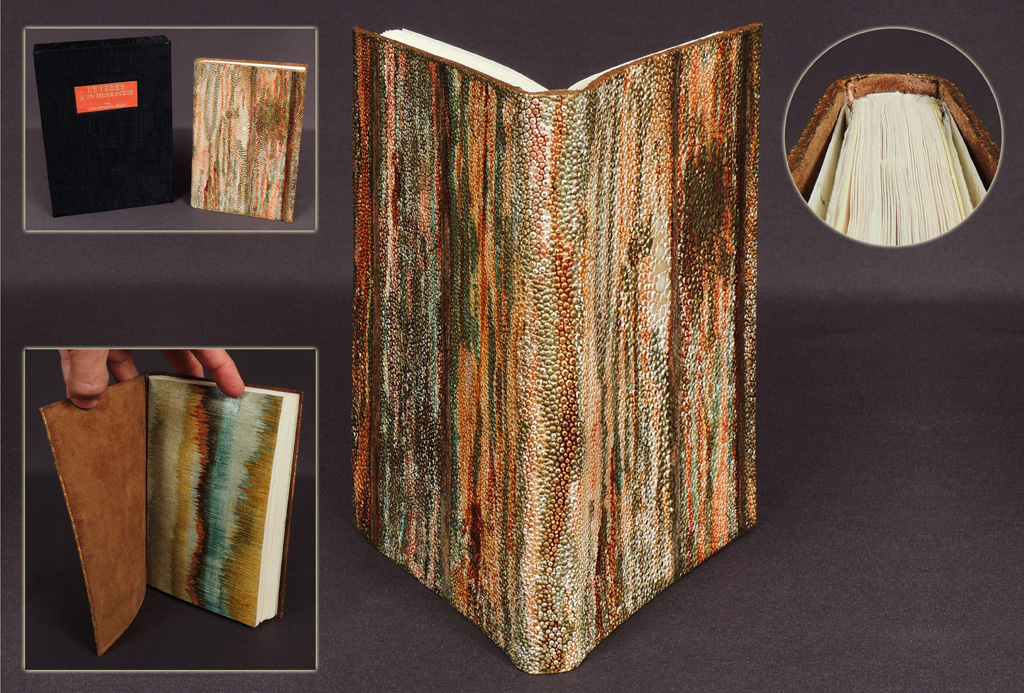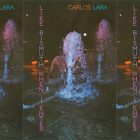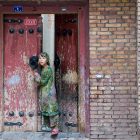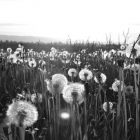“Another Way to Honor the Book”: An Interview with Odette Drapeau
Bookbinder Odette Drapeau has been internationally honored for her modern and dynamic approach to what is often considered a traditional craft. To Drapeau, the book is both “a visual and tactile object where the container and content can connect to generate other visions.” While continually experimenting with new concepts that transform her practice, Drapeau also remains committed to what she calls the true nature of the book—being easy to use and inviting to read. Her professional career spans more than 40 years, from her early studies under book-gilding specialists in Paris and Montreal, to her most recent solo exhibitions at the Lower Saint Lawrence Museum in Québec and Historical Library of the City of Paris. Drapeau is a native of Montreal, where she lives and works.
Lara Palmquist: I first encountered your art through this year’s Nobel Museum Book Binding Exhibition, where your bindings of books by recent laureates Mo Yan and Alice Munro are currently on display. Can you talk about your process and goals in creating these two works?
Odette Drapeau: The Swedish Bookbinders Guild celebrated Nobel Prize-winners Alice Munro (2013) and Mo Yan (2012) at the Nobel Museum in Stockholm by inviting bookbinders from China, Canada, and Sweden to participate with titles from these two remarkable authors.
I felt at home with Alice Munro’s great sensitivity and intense femininity. Creating a “back to back” binding of Runaway allowed me to join the English version to the French translation, choosing white leather for the French and pink for the English. I wanted to unify those books while making them distinctive. Mo Yan’s writing also captivated me—reading his work was a pleasant discovery. Because the meaning of color is very important in China, I chose red and orange to bind a French translation of his two stories “Le veau” (The Calf) and “Le Coureur de Fond” (The Distance Runner); those colors bring luck and happiness.
LP: As a bookbinder dedicated to continually pushing the boundaries of your artistic practice, you have engaged with several unusual materials, including marine leather. What first inspired your interest in fish, ray, and eel skin, and how do these materials continue to inform your work?
OD: I have been dedicated to marine leather for more than thirty years. My discovery of fish leathers— tanned in Gaspésie, Québec—emerged as a lever to unlock change. Suddenly, I had a new medium to work with, a flexible and durable material offering rich natural colors, inviting textures, and varied shades. These new elements enabled me to begin creating original bindings in arrangements comparable to pictorial works without sacrificing the 3D structural contribution of the classic binding.
LP: Supported by a Research and Creation Grant from the Canada Council for the Arts, you recently began experimenting with “smart-textiles,” fabrics woven with sensory microcomputers that respond to external stimuli. You’ve stated that you incorporated this material into your practice partly in response to the arrival of the electronic book. What possibilities do you foresee for the future of books and bookbinding, particularly with the use of these new textiles?
OD: The idea of exploring the world of smart textiles appeared inevitable to me. This project has been welcomed by the Council for the Arts, which has allowed me to devote all of my time to this research. I discovered smart textiles were opening new and dynamic opportunities which offered bookbinders another way to honor the book.
I’ve now spent four years on research and experimentation in this area, and developed a technique that is best adapted to work with the fibers. I banned wet adhesive, which is incompatible with the sensitivity of the fabrics, and the needle and thread became my new work tools. After all of my explorations with smart textiles, I am now creating contemporary works that combine light, flexibility, and reader interaction.
For example, my art installation “Cat Walk” features a luminous binding of Adeline Rognon’s Le Défilé de Mode. This illustrated book is centred on red St. Armand paper, bound in black fishnet stockings and mother-of-pearl buttons, and sewn as an accordion that unfolds over three meters. In collaboration with Jean-Pierre Guité, a specialist in electric circuitry, I then incorporated light emitting diodes (LEDs) and sensors, which detect when the reader passes by and illuminate the pages of the book. I’ve also created bindings with lights added to the spine, such as my binding of French symbolist poet Stéphane Mallarmé’s Un Coup de Dés Jamais N’abolira le Hazard.
I am currently preparing more installations that incorporate light into my bindings and around my creative works.
LP: One of the aspects that I most admire about your approach to bookbinding is your devotion to the transmission of ideas. You’ve studied under master bookbinders in both Montreal and Paris, and often work with specialists when exploring new approaches to your craft. You have also organized numerous bookbinding workshops, served as Chair of the Association of Québec bookbinders, and founded Air Group Nine, an international community of bookbinders who aim to “think, imagine, and create the binding of tomorrow.” How does collaboration inspire your artistic innovation?
OD: Since the beginning of my commitment to bookbinding I have often collaborated with writers, jewelers, embroiderers, potters, and especially with Alena Prochazca, an architect who helped realize the installation Le livre de l’an 3000 – Mémoire de la vie urbaine (The Book of the Year 3000—Memory of Urban Life) at Bonsecours Market in Montreal. This installation offered a revealing memoir of our times, customs, and multiple cultures. The event called for the participation of the people of Montreal, who were invited to take part by recording their feelings and thoughts about urban life on circular leaves of paper, which will now be preserved for future generations—the giant pages were made of virtually indestructible rag paper specially crafted for the project.
I also directed an art gallery dedicated to the artist’s book, which allowed me to collaborate by educating a wider public about the art and beauty of books. Beyond these personal experiences in my career, I am also an inveterate consumer of art. In Italy and France, I never tire of seeing the work of Giotto and admire the great names of Renaissance artists as well as the beauty of art nouveau and art deco. I also have a great attachment to modern and contemporary artists.
For decades, I taught workshops on French traditional bookbinding techniques. While demanding in the level of quality, I always wanted to develop in my students a taste for aesthetics and balance, as well as an appreciation for work well-done, which adds to the book not only protection but also beauty.
LP: Which authors have been particularly influential on your development as a bookbinder?
OD: My culture is French and I read in French. This literature is full of great writers and poets. I also frequent foreign authors: Russian authors, English, American, South American and more. I even like rereading, and keep all of my books to sometimes flip through and find a detail of the story that I had forgotten. In my view, reading is a necessary habit for my existence, a habit that I describe as rewarding and beneficial.
In 1992, I attended a conference in Paris on Stendhal, the nineteenth century French writer. On this occasion the “Bibliothèque Historique de la Ville de Paris” invited bookbinders to bind books by this author. I met a professor from McGill University, Madame Gabrielle Pascal, who is a Stendhal specialist. Accompanied by the Israeli artist Maurice Hayoun, we developed a limited edition of 33 copies of a book that revived the story of Stendhal’s life in Civitavechia, a small port near Rome. This book, Visse, Scrisse, Amo (He Lived, He Wrote, He Loved), was bound in black eel skin and purchased by the National Library of France. This type of experience significantly influenced me because of the special attention given to achieve a prestigious edition. I also admire the French author Michel Butor for his engagement with artists and the beauty of his texts.
Photo: Lettres á un Jeune Poète (Letters to a Young Poet) by Rainer Maria Rilke, soft bound by Odette Dapeau in painted shagreen (ray skin) with suede endpapers and doublures. Accompanying box bound in black crumpled silk.




